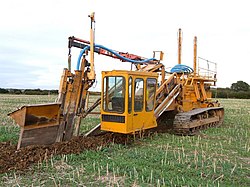Mole drainage implement - geograph.org.uk - 760037
(c) Trevor Rickard, CC BY-SA 2.0
Autor/Urheber:
Shortlink:
Quelle:
Größe:
640 x 480 Pixel (139575 Bytes)
Beschreibung:
Mole drainage implement. The 1926 and 1930 Land Drainage Acts and the Agricultural Act 1937 provided partial grants to farmers for improving drainage. However, digging trenches and laying clay pipes or tiles was expensive, so despite the grants, farmers often never recouped their own costs. As a result, the Ministry of Agriculture turned to investigating machinery. During the 1930s, machines based on those used for laying water supplies etc made little impact because the expense was still too high. The Ministry eventually put considerable energy into promoting mole drainage implements which could be tractor-drawn. The approach was to drag a pointed object at a constant level below the surface. To work, the land needed to be predominately clay to prevent soil crumbling from in-filling the hole. Land also needs to be on a slope to allow the water to run off below ground. Of course clay soils tended to be the wettest, so this method proved more popular. Even then, it was likely that repeat moleing would have been needed every five years or so. This implement looks to be about 1960 vintage and would have been a predecessor of todays machines (but without the pipe layer part), cf. [1].
Kommentar zur Lizenz:
Dieses Bild stammt aus der Sammlung des Projektes „Geograph British Isles“. Siehe die Seite der Fotografie für Kontaktinformationen. Das Urheberrecht dieses Bildes liegt bei Trevor Rickard und ist lizenziert unter der Creative Commons Namensnennung-Weitergabe unter gleichen Bedingungen-2.0-Lizenz.
Lizenz:
Credit:
Relevante Bilder
Relevante Artikel
Drainage (technische Systeme)Mit Drainage, auch Dränage, stärker verdeutscht Dränung, bezeichnet man Maßnahmen unter Einsatz technischer Systeme und auch diese Systeme selbst, die Vernässungen an Bauwerken und auf landwirtschaftlich genutzten Flächen entgegenwirken. Dazu wird das Wasser erfasst und zielgerichtet abgeleitet. Diese Vernässungen können unterschiedliche Ursachen haben:hoher Grundwasserspiegel, Fremdwasserzufluss, Stauwasser, Regenwasser. .. weiterlesen
























